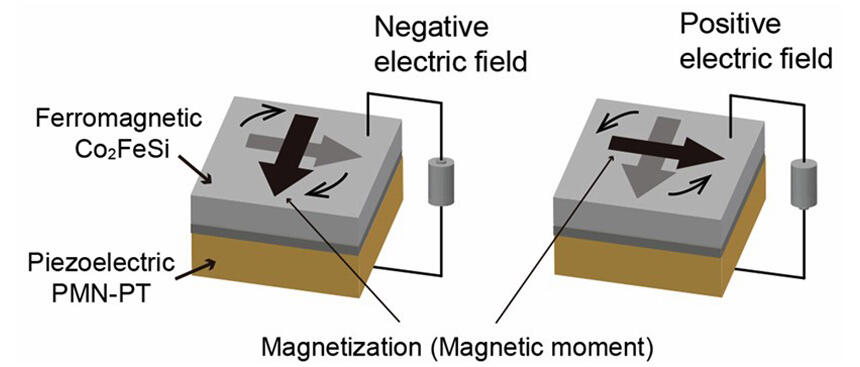A joint research group led by graduate student (at the time of research) Shumpei Fujii, project researcher Takamasa Usami, Professor Kohei Hamaya, of the Graduate School of Engineering Science, Osaka University, Associate Professor Yu Shiratsuchi of the Graduate School of Engineering Science, Osaka University, and Associate Professor Yoshihiro Gohda of the School of Materials and Chemical Technology, Tokyo Institute of Technology, has achieved the world's highest level performance index (magnetic electrical coupling coefficient) in developing a high-performance interfacial multiferroic structure for new voltage information writing technology in spintronics devices. At the same time, they successfully demonstrated repeated switching of nonvolatile memory states by applying an electric field.

Provided by Professor Kohei Hamaya, Center for Spintronics Research Network, CSRN-Osaka University
A challenge for magnetoresistive memory (MRAM), which is expected to become the next-generation of nonvolatile memory devices, is that it consumes a large amount of power because current is passed through its metallic magnetic material when information is written. The research group has demonstrated a high-performance interfacial multiferroic structure consisting of a high-performance metallic magnetic material and a piezoelectric material bonded together using their own technology, and developed a technology to switch the magnetization direction of the metallic magnetic material efficiently by simply applying voltage instead of an electric current. They fabricated a new interfacial multiferroic structure combining Co2FeSi, a kind of Co-based Heusler alloy magnet known for its high spin polarization ratio as a ferromagnet, and Pb(Mg1/3 Nb2/3 )O3 -PbTiO3 (PMNPT), a type of piezoelectric material with high piezoelectric performance, with high quality, and succeeded for the first time in the world in achieving a magnetic-electric coupling coefficient of 1.0x10-5 s/m, which was a barrier to practical use. Furthermore, they realized repeated switching of nonvolatile memory states by applying an electric field.
"This is a low-power information writing technology that can be incorporated into all next-generation spintronics devices, including MRAM," says Professor Hamaya. "Going forward, we would like to advance our research with a view to integrating it with next-generation semiconductor devices and develop it into a technology to overcome the problem of power consumption, which has seen an explosive increase as an issue amid the development of IoT and AI technologies."
■ Interfacial multiferroic structure: A structure consisting of two layers of a ferromagnetic material and a piezoelectric or ferroelectric material (a material in which polarization occurs spontaneously and the spontaneous polarization can be reversed by an electric field), in which the magnetic state can be controlled by an electric field.
Journal Information
Publication: Nature
Title: Giant converse magnetoelectric effect in a multiferroic heterostructure with polycrystalline Co2FeSi
DOI: 10.1038/s41427-022-00389-1
This article has been translated by JST with permission from The Science News Ltd.(https://sci-news.co.jp/). Unauthorized reproduction of the article and photographs is prohibited.




